4 October 2013
In response to great demand, we have decided to publish on our site the long and extraordinary interviews that appeared in the print magazine from 2009 to 2011. Forty gripping conversations with the protagonists of contemporary art, design and architecture. Once a week, an appointment not to be missed. A real treat. Today it’s Sergio Vega’s turn.
Klat #02, spring 2010.
The search for the Garden of Eden and the colonization of South America, the story of the parrot and the myth of the perfect language, Brazilian modernism and Walter Benjamin’s hashish. The work of Sergio Vega is a kaleidoscopic journey through the foundational myths of Western society, to reinterpret the history of modernity and to shed light on the gap between ideology, colonialism and literature. From Mato Grosso to the dark alleys of Naples, Sergio Vega shows how contemporary art can become a peerless critical exercise at the service of restless, uncompromising thought.
Let’s start our conversation by talking about Paradise. For many years you have gone forward with a complex research project called Paradise in the New World, focusing on the myth of the Garden of Eden. According to one of the most fascinating traditions of Western culture, the Earthly Paradise has never disappeared, but continues to exist, hidden in some remote part of the planet, often identified as being in South America. Could you tell me how you became interested in this myth?
I was interested in Latin America as a sign of otherness, or of exoticism, according to cultural stereotypes. An otherness constructed as the image of desire. I was convinced that the only way to dismantle the stereotypes was not to avoid them but to reveal them in three dimensions, to let them speak. So I began to study the history of the colonization of the Americas. Through that research I discovered the 17th-century theory of Antonio de León Pinelo, according to which the Garden of Eden should be located in the center of South America. All my ideas started to come together around a common thread. I had found the lens, the filter to see through the history of colonialism and the present condition of South America. The belief that Eden was not destroyed by the Flood, in fact, had enormous consequences for the expansion of Catholicism in the New World: the supposed existence of Paradise in South America sustained the proselytizing of the Church and justified the colonization of those lands. Today, even environmentalists would presume out of intuition that Eden might be hidden somewhere in the Amazon jungle. The Amazonian forest is the site of the imaginary where the theory of evolution overlaps the myth of the Garden of Eden.
How have you untangled this weave of literature, historical events and ideology? I know you have spent lots of time researching the subject in books, but you have also made a number of trips to Mato Grosso, in Brazil, to get direct experience of the territory.
Paradise in the New World is built like a travel diary, with images and narrative, put together during and after my explorations. The narrator takes on different roles, as if he had multiple personalities. Joyce’s stream of consciousness is a crucial reference point in this sense. The writing was also influenced by Mikhail Bakhtin’s theory of the novel as a parody of other genres. The Western narrative of paradise has never been a text about the present, it has always been constructed by imagining a remote past: to create a tradition, an epic distance between that world and contemporary reality. Starting with Bakhtin’s reflections, I wanted to base my project on the transformation of the Book of Genesis into a novel, making it the object of a familiar, indeterminate narration, open and comical, a parody, as if the moment of creation were still in the very midst of its unfolding.
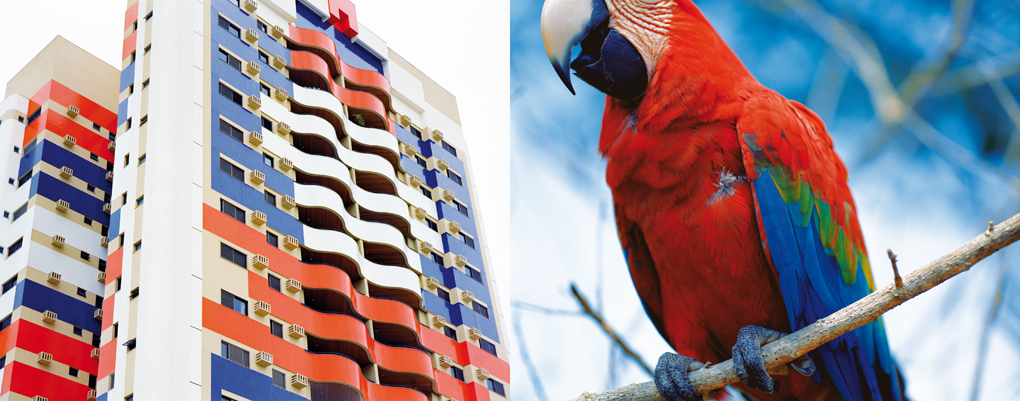
Sergio Vega, Modernismo Tropical, 2000. Courtesy: Sergio Vega.
Your take on Paradise is very interesting because it reveals how, in the Genesis, culture and nature are still joined in a whole, as two aspects of the same unit. It is surprising how we continue, in Western civilization, to emphasize the division between nature and culture, forgetting that at its origin, in the Book of Genesis, the two elements are exactly the same thing. In this sense, the way you have approached the figure of the parrot, in a number of works, is quite intriguing.
Yes, you are correct in mentioning the parrot in relation to the schism between nature and culture. As you know, Jean Delumeau has contributed greatly to our comprehension of the iconology of the parrot, demonstrating that in the 1600s the parrot was the bird of paradise, par excellence. According to the tradition, in Eden all the animals could speak, but after the original sin they lost that faculty, becoming mute, with the exception of the parrot: the only witness to those events that can still talk. Even for those who know nothing of this story, the parrot is an emblem of paradise, because it represents a reconciliation between nature and culture, as it is the only animal that uses language. The parrot expresses the desire for paradisiac unity, the hope for a unifying myth, an Eden not yet corrupted by the mystifying action of colonialism. In the video I made entitled Genesis According to Parrots, parrots speak, equating tales of colonization with the events at the Garden of Eden narrated in the Book of Genesis.
This stratification of cultural planes brings to mind another foundation myth of the Occident, which you seem to draw into your work. It is the myth of the perfect language, the desire nurtured for centuries by scientists, linguists and explorers to find the perfect tongue, capable of overcoming the Babelic confusion and uniting all men in the ease of a common language. Umberto Eco has conducted extensive research on this theme…
From the outset of my project I had in mind Eco’s extraordinary research on the various attempts made throughout history to reinvent the perfect language. Paradise in the New World does not seek a perfect language, but it is an attempt to find a common harmony among different languages, an expressive pluralism articulated in different media. My first impulse, when I saw a phone booth in the form of a parrot in Mato Grosso, was precisely to use it to call Umberto Eco! It is ironic, but the desire to take the world back to its Edenic origins, to make the language of Adam accessible once again for everyone, becomes even more urgent today because of the failures at communicating generated by globalization.
You grew up in Argentina, then moved to New York about twenty years ago to participate in the Independent Study Program of the Whitney Museum. You have taught photography at the University of Florida for several years now. What type of influence has this path had on your work?
If you come from Latin America and you find yourself working in an international context you inevitably begin at a disadvantage. You cannot afford to speak as if people were familiar with your subject matter, the way American artists can, for example. When Warhol used Marilyn or Campbell’s soup, his discourse worked because everyone knew what he was talking about. If you use parrots or Che Guevara, on the other hand, you have to explain that you are not doing it because you are naive, but because you are involved in a project of cultural theorization, of a critical investigation of myths. The Whitney experience brought me deeper into theoretical research, even though my approach to theory has always been idiosyncratic. I derive a certain pleasure from making a mischievous blend of theorizations from different sources and disciplines. That act of blending is not predicated on chance, but on a critical interpretation of theories, a performance rigorously based on my own experience with the subject matter. In addition, my investigations are also born from necessity, because many of the topics I address have not been previously researched in the context of contemporary art. As far as my teaching is concerned, it is fundamental for my research, especially due to the possibility it offers to come to terms with other opinions and viewpoints, in a situation of free, lively exchange.
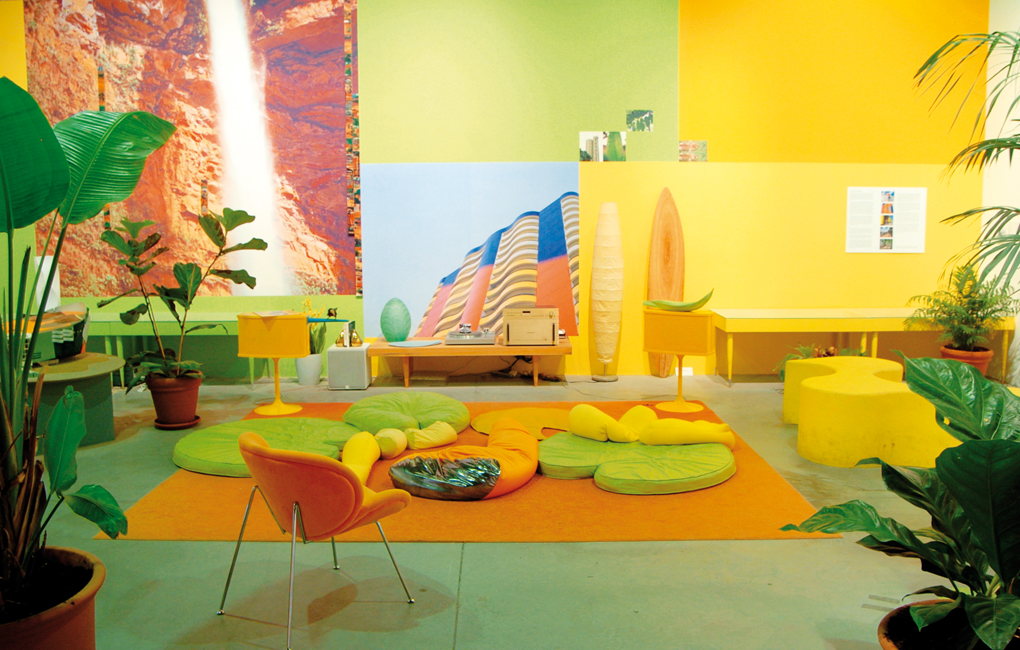
Sergio Vega, Tropicalounge, 2005. Biennale di Venezia, Courtesy: Biennale di Venezia.
In recent years, many South American artists have gained widespread international recognition, from both critics and the market. This phenomenon is problematic, though, because South American artists have often been used to satisfy the art market’s desire for exotic territories that can be commercially exploited. Have you ever felt like a part of all this? On this topic, I’d like to ask you about the experience of participating at the Venice Biennial in 2005, in the Arsenale curated by Rosa Martinez.
The commercial exploitation of exoticism determines the way art is produced and consumed. Today art reaches the market only after it has been thoroughly tamed, like the “noble savage”, i.e. translated into the values of Eurocentrism, according to the canons of conceptual art and minimalism. In other words, there is no longer the search for an “authentic other”. It seems to me that the viewers aren’t even interested in being surprised anymore, they just want to find confirmation of what they already know, with an added dose of spice. In this sense, the artists of my generation have had to deal with a certain quantity of dictates and restrictions. For an exhibition organized by MoMA New York in 1993, Latin American Artists of the Twentieth Century, the organizers asked the guests in the printed invitation to the opening to “dress colorful”. In those days cultural stereotypes functioned as a filter to include or exclude artworks based on geographical origin, nationality, gender, race or ethnicity. The result was a strange mixture of racism and cultural condescension, but in the end those attitudes revealed themselves as symptoms of mere ignorance, a true lack of interest in knowing about other cultures, in keeping with a logic that unfortunately still exists today. By choosing not to give up the “color” in my work, I made things harder for myself. To overcome the barriers I had to take the cultural background of the viewers into account. On the one hand I expect them to have a sense of humor about themselves, because I tease them, inviting them to have fun and enjoy the sensorial experience as if they were on vacation. On the other, I offer them a great quantity of material to process, and I expect them to devote a great deal of attention to the works. They have to be willing to read, to learn things they probably didn’t already know. The experience of the Venice Biennial was very satisfying, in this sense. Immediately right after walking into the installation, the visitors could sense that their desires for exoticism had been anticipated, sliced thin and reformulated into various critical formations. People kept returning and discovering things that hadn’t immediately noticed. The installation became a sort of meeting place, a place to spend time. Some people even fell asleep, laying on the cushions. It was always full. The Italian press also noticed the Pappagalli in Biennale, which was the title of the review that appeared in Il Sole 24 Ore.
I’m curious to find out something more about your research on South American modernism. You have coined the term modernismo tropical to describe the fate of modern architecture in South America, its baroque, excessive, paradisiacal dimension, in strident contrast with the European version. It seems to me that at the heart of your investigation of these themes there is an attempt to unmask the ideological implications of tropical modernism as an architectural expression of the ruling class. Is the history of modernism a basic focus of your work?
The history of modern architecture was not immediately a central focus in my work. That is because in Argentina modern architecture had not been very relevant to the country’s cultural identity. Countries like Brazil and Venezuela, on the other hand, had a very different history. Modernismo Tropical started when I was in the city of Cuiabá, in Mato Grosso, looking for Paradise, and I happened to run into a row of buildings that really perplexed me. They were clearly modernist, at least in style, but they could never have come into being in any other place:
«Tall buildings were distributed alongside, as if they were in a carnival parade, but instead of dancing to the rhythm of deep African drums, they seemed to be swinging to the smooth sound of bossa nova. Their monumental presence ostentatiously announcing the triumph of modernity over the jungle. The facades of those carnivalesque buildings were made of bright pure colors, with curved balconies of organic design. Some were aesthetically refined, others silly but fun, many others painful to look at. I concluded that this tropical architecture establishes a dialogue with nature not in order to camouflage itself, but to contend with it. In some cases, it acquired an emblematic presence that not only competes with mango trees, coconut palms and parrots, but also imitates them. The materialism embodied in these buildings has nothing to do with dialectical logic, but it is the fruit of excess that the modern as a sign of social status acquires in the societies of the Third World. […] It is the case of an architecture drunken by and sunken into the eccentricity of kitsch, a kind of unleashed, paradigmatic kitsch that submerges all of what is modernist. As a result […] it manages to generously resuscitate the modern as a parody of itself». Excerpt from El Paraíso en el Nuevo Mundo by Sergio Vega, Palais de Tokyo, Paris Musées, 2006.
After seeing these buildings, I felt the need to dissect the path taken by their architects, to understand where they came from. This led me to examine the influence of the great modernists of Brazil: Lucio Costa, Oscar Niemeyer and Roberto Burle Marx, among others. Finally, I went to Brasilia, which seems like a place designed by Martians in the 1960s. A modernist Disneyland made by the Martians we imagined in the 1960s! With the kind of social problems that Brazil has, like the percentage of poverty and illiteracy in its population, this radical aesthetic planning implemented by the government as an image of itself seems extremely hard to swallow. In Latin America the “modern” always functions as the sign of a social elite, of power and wealth, over and above the Marxist intentions of the architects. Some may not agree with me, especially those who believe that modernism brought democratic salvation to society. In Latin America, nevertheless, I have never met a single person among the underprivileged that could be considered a “modernist”.
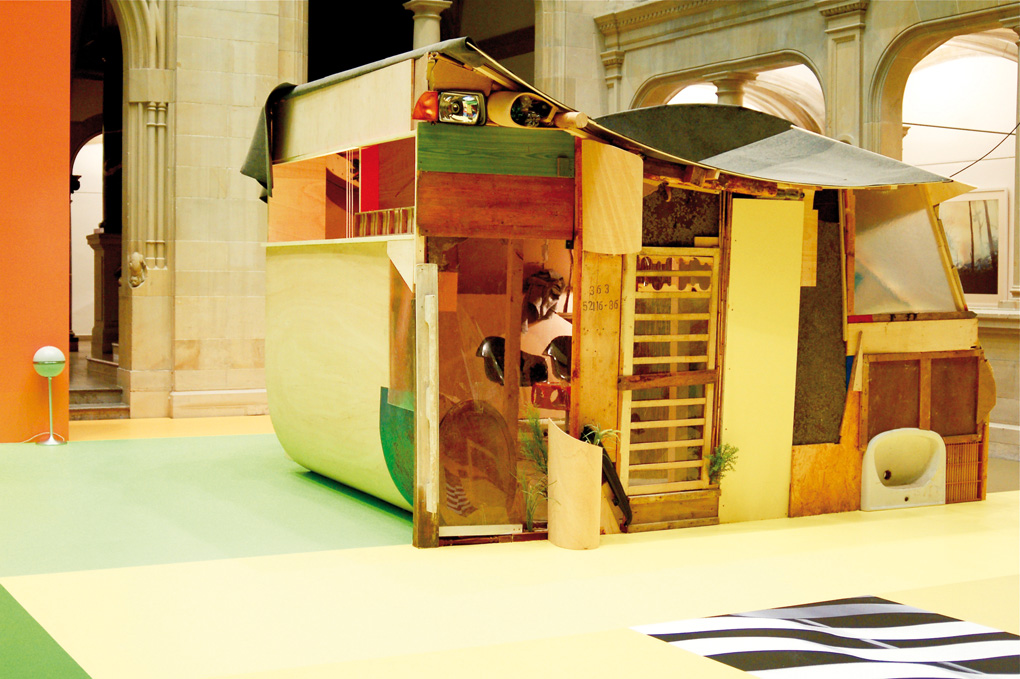
Sergio Vega, On the Mimetic Faculty, 2008. Landesmuseum, Münster.
This reminds me of the exhibition held last year at the Landesmuseum of Münster, in Germany, an excerpt from Paradise in the New World. In that project, you concentrated on the architecture of the shanty towns that surround big South American cities, where the people live in conditions of permanent emergency and transition. The shanty towns offer a sharp contrast with respect to the glittering luxury of the modernist architecture we were talking about before. You have written about the collage aesthetic of the shacks, in which the form is subject to the urgent needs of function, creating an opposition between modernist Cartesian logic and what you call the post-Cartesian approach.
What I call post-Cartesian, in this context, has to do with the recycling of materials and ready-made objects that had been discarded. A shanty seen as the result of improvisation based on need, resembles certain strategies employed in artmaking. It looks like an aberration of the medium of collage, because the overlaying of different materials taken out of their original contexts is merely functional, without any aesthetic considerations. In 2000 I started building shacks in exhibition spaces because they seem to elicit a vast range of responses. Their presence in art contexts is uncanny, strange and familiar at the same time. A shanty in a museum functions as the signifier of the raw, marginal reality of the shanty town, generating a sense of discomfort in the art viewers. It’s a different discomfort from the one you feel when you enter a shanty town in the real world. These constructions of mine are made to function as a theatrical device (like a museum or a theme park), so the visitors are more comfortable without having to risk a true encounter with the unknown. It is funny to see how elites have become interested in colonizing poverty for their aesthetic pleasure. The shack I made for Münster was called On the Mimetic Faculty, a reference to the essay by Walter Benjamin. The initial and rather absurd premise was, that if distinctions in society were of true essence, then different social classes would be inclined to behave like different species. Thus, disadvantaged social groups may employ high design at making their shanties in order to camouflage themselves into more socially acceptable conditions. Testing the notion that modernist style is not an exclusively upper class paradigm, I employed it in the making of a shanty. The result was something that doesn’t exist in the real world, but could nevertheless be plausible: the virtue of aesthetics employed to redeem poverty. Being inside this “dwelling” meant living for a moment in poverty, but with style, inside a “designer-shanty”.
One of your works I admire is The Ants and the Soap (2009). Observing the accidental encounter between ants and a bar of soap in Mato Grosso, you have developed an inexhaustible philosophical investigation on the meaning of art and its consumption. This work is a sort of statement on your interest in investigating the role of culture in the present, untangling its enigmas and political implications. Did you follow a precise strategy?
It was a chance encounter. I did not have any strategy, other than to document this accidental meeting and to try to interpret it. I was in a small hotel at Chapada dos Guimarães, in Mato Grosso. Entering the bathroom, I saw some ants moving around in the soapdish. It was as if the soapdish had become a little room, and the glycerin soap had taken on the status of a monumental sculpture, in relation to the size of the ants. When I went back into the bathroom two hours later the ants were still there, moving in a circle, so I decided to study this curious phenomenon and to shoot it with my video camera. I realized that in that zone, at a certain time of the year, the ants usually pollinate the flowers of the fruit used to produce the fragrance of the soap, the Cupuaçu. This was not the season of the pollination, but the ants had smelled the fragrance of the soap from far away, in the garden. Responding to a programmed desire, the entire colony of ants, in a long row, one by one, had gone through the soapdish. It was a moment in which culture confused nature. All those ants intent on walking around the soap, in a state of wonder, reminded me of the large number of visitors attending big international art exhibitions, so I wondered if for those little insects this might not be a sort of encounter with art…
It’s one of your most philosophical works, an incisive critique of the commodification of art and culture, set forth along conceptual lines close to those of the School of Frankfurt, and particularly the writings of Adorno and Marcuse. What are you interested in retaining from their approach to culture? Personally, I think their model of ideological critique is still very valuable.
If the 19th century was the century of ideology, the 20th was undoubtedly that of its critique, and the model of the School of Frankfurt is still the most important point of reference, in this sense. In the 1930s, while they were theorizing a harsh critique of capitalism, the philosophers of the Frankfurt School had understood that most of the followers of Marx had come to parrot a limited selection of his ideas. Today we are still engaged in the same dialectical effort. The question remains how to reinstate the core of critical theory into practice, keeping it from getting watered down into bland liberalism, or getting ossified in an orthodoxy based on mere nostalgia. When the Institute for Social Research moved to New York, its heterodox critique of capitalism became an indictment of Western civilization as a whole. We can see the roots of the nightmares of the present day (globalization, runaway capitalism and environmental crisis, to name a few) in what the Frankfurt School was forecasting back then. Almost the whole history of art in the 20th century revolves around the problem of the aura of originality of the work of art. During the 20th century art continuously failed in its attempt to shake off this problem. Artists have done what was possible to invent an art that couldn’t be turn into merchandise. Yet the art world we have promotes connoiseurship and consumption, fetichizes and commodifies everything. The critical issue of art today is no longer to challenge the status of art itself (if it’s art or if it’s not art) or to refuse its commodification. The merchandising happens automatically, as soon as you present works in an art context. In my view, what matters today more than anything, is what art does and what the viewer can do with it. Whether or not this is carried out by the mere investment of user values into aesthetic practices remains yet to be seen. What I mean by focusing on “what art does” is on one hand to examine the kind of influence it exerts in society and what kind of culture it produces around itself. On the other hand, to question what model of being in the world art proposes for the subject who engages with it, and how this subject could put into practice that knowledge gained from the experience of art.
That brings me to a question about your latest project, an exhibition at the Umberto Di Marino gallery in Naples. Your starting point was Walter Benjamin’s short essay on that city. Benjamin was impressed by its relational structure (its “porosity”), in which he glimpsed the possibility of a new form of sociality. How did you organize your interests with respect to this city?
The layering of cultures in Naples is an endless field for research and interpretation. The idea of the project was to combine Benjamin’s texts on Hashish in Marseille and Naples. I think these texts interact in a fluid way, because they represent a gaze directed toward the Mediterranean as an exotic destination, from a Northern European perspective. I used Benjamin’s piece on Naples as a map of the city, to go to the same places he described, exploring them under the influence of hashish. It was like working with an outdated map, but one that still described the basic structure of the city with incredible clarity. Reading Benjamin’s text it is possible to sense how he was seduced by the way of life of the Neapolitans, a style very distant from Northern European customs, with its fluid interpenetration of private and public, and its love of improvisation. I did not organize any preliminary visits to the city to plan the video shoot, I relied only on direct encounters, with a hand-held camera. Following this path of “profane illuminations”, I explored the various places and life styles of the city in unexpected ways. The video Hashish in Naples uses Benjamin’s narrative to interpret Naples today, through my experience. The possible overlay of the two dimensions is what motivated me to do the project. The point was to have something written in 1926 and to bring it back to life, as if it were made of occasional thoughts that come as you roam the streets. A simulation of thought in real time, as if the screen were a window that shows what my eyes see and what my thoughts are at the same time.
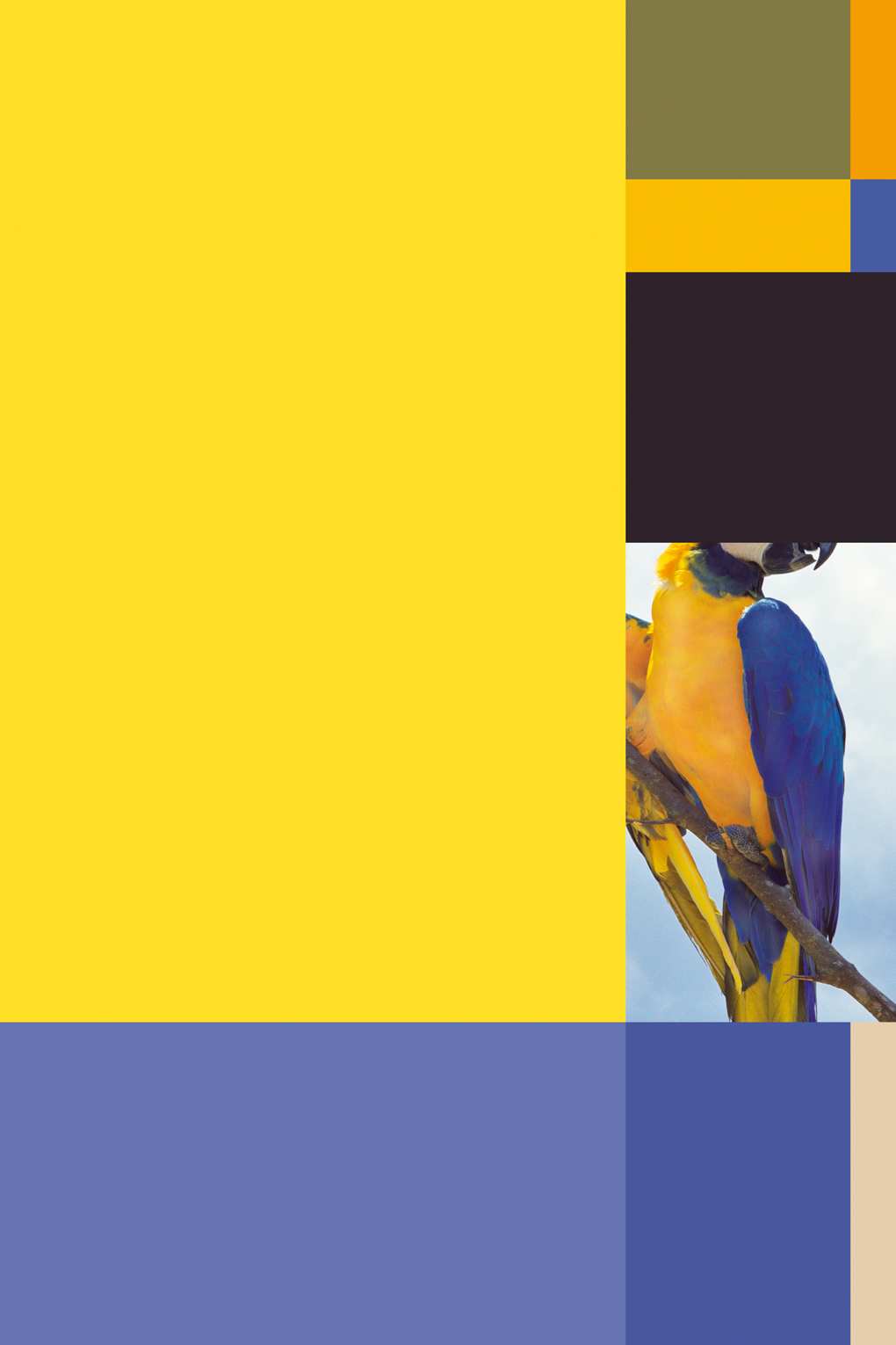
Sergio Vega, Parrot Color Chart #3, 2008 Courtesy: Galerie Karsten Greve, Paris.
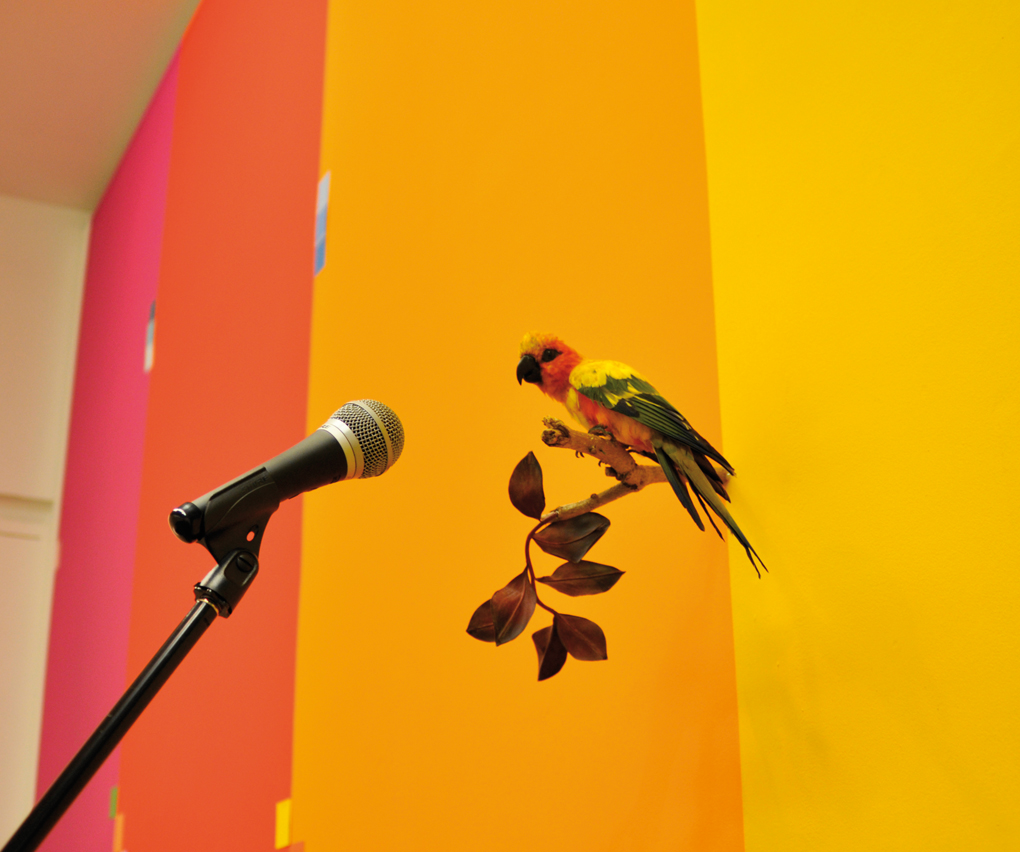
Sergio Vega, Across the Corpus Callosum, 2009. Courtesy: Galerie Karsten Greve, Paris.
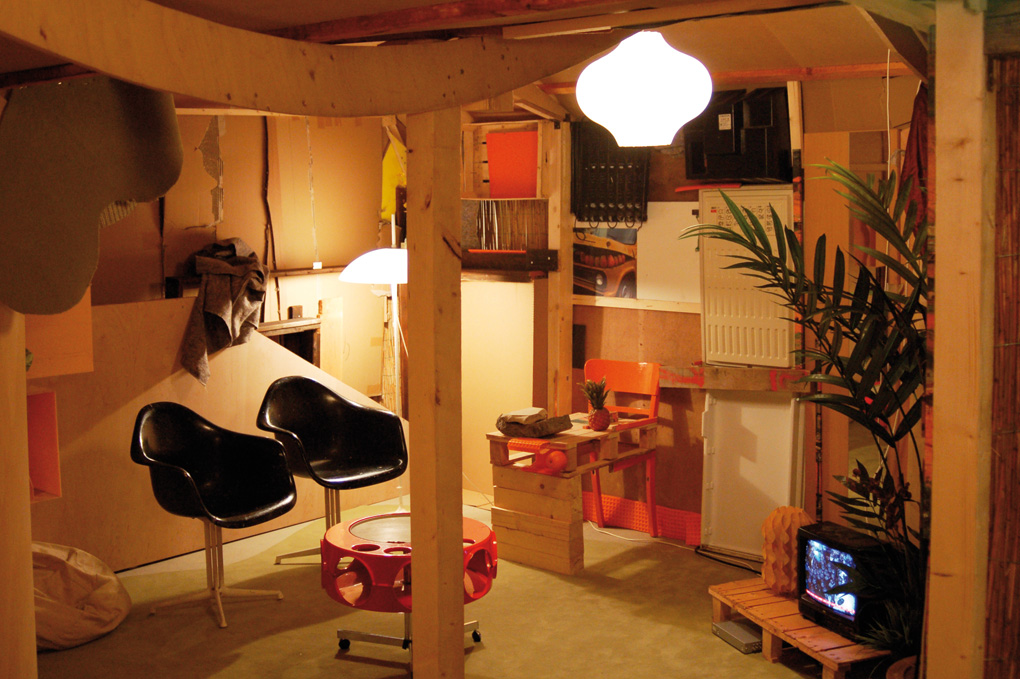
Sergio Vega, On the Mimetic Faculty (detail), 2008. Landesmuseum, Münster.
